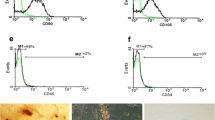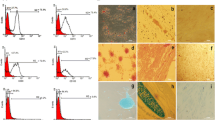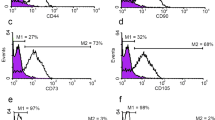Abstract
In regenerative medicine, MSCs need to be pluripotent for better results. In this study, the effect of fibrin scaffold on expression of stemness genes was examined. Adipose-derived MSCs were cultured in tissue culture plates (2D) and 3-dimensional (3D) fibrin scaffolds. The effect of fibrin scaffold on proliferation of adipose-derived MSCs was evaluated by MTT assay. The expression of stemness genes (OCT4 and SOX2) were evaluated by qRT-PCR, and flow cytometry was done for Nanog protein level. Cultured MSCs on fibrin scaffold were able to proliferate according to data obtained by MTT assay. Expression of OCT4 and SOX2 had a significant increase in cells were cultured in 3D condition compared to 2D condition (P < 0.05). Also, increased expression of Nanog protein in 3D culture was observed (P < 0.05). OCT4 and SOX2 in 3D condition increased two-fold and three-fold respectively in 2D and 3D conditions. Moreover, expression of Nanog increased 30% more than in 2D condition. Evaluation of important pluripotency regulators such as OCT4, SOX2, and Nanog showed that fibrin scaffolds are useful instruments to maintain stemness of MSCs, which is essential in field of stem cell therapy and regenerative medicine.









Similar content being viewed by others
Abbreviations
- MSC:
-
mesenchymal stem cell
- 2D:
-
two-dimensional culture
- 3D:
-
three-dimensional culture
References
Al-Nbaheen M, vishnubalaji R, Ali D, Bouslimi A, Al-Jassir F, Megges M, Prigione A, Adjaye J, Kassem M and Aldahmash A 2013 Human stromal (mesenchymal) stem cells from bone marrow, adipose tissue and skin exhibit differences in molecular phenotype and differentiation potential. Stem Cell Rev. Rep. 9 32–43
Bensaïd W, Triffitt JT, Blanchat C, Oudina K, Sedel L and Petite H 2003 A biodegradable fibrin scaffold for mesenchymal stem cell transplantation. Biomaterials 24 2497–502
De Francesco F, Ricci G, D’Andrea F, Nicoletti GF and Ferraro GA 2015 Human adipose stem cells: from bench to bedside. Tissue Eng. B Rev. 21 572–584
Gamboa-Martínez TC, Luque-Guillén V, González-García C, Gómez Ribelles JL and Gallego-Ferrer G 2015 Crosslinked fibrin gels for tissue engineering: Two approaches to improve their properties. J. Biomed. Mater. Res. A 103 614–621
Han S, Zhao Y, Xiao Z, Han J, Chen B, Chen L, et al. 2012 The three-dimensional collagen scaffold improves the stemness of rat bone marrow mesenchymal stem cells. J. Genet. Genomics 39 633–641
Ka L, Kong H, Cell S, Shing LK and Surgery O 2014 Tissue-specific stem cells concise review: the surface markers and identity of human mesenchymal stem cells pp 1408–1419
Kolehmainen K and Willerth SM 2012 Preparation of 3D fibrin scaffolds for stem cell culture applications. J Vis Exp. 61 3641
Lü D, Luo C, Zhang C, Li Z and Long M 2014 Differential regulation of morphology and stemness of mouse embryonic stem cells by substrate stiffness and topography. Biomaterials 35 3945–3955
Ma S, Xie N, Li W, Yuan B, Shi Y and Wang Y 2014 Immunobiology of mesenchymal stem cells. Cell Death Differ. 21 216–225
Mosna F and Sensebe L 2010 Human bone marrow and adipose tissue mesenchymal stem cells: a user’ s guide. Stem Cells Dev. 19 1–53
Ra JC, Shin IS, Kim SH, Kang SK, Kang BC, Lee HY, Kim YJ, Jo JY, Yoon EJ, Choi HJ and Kwon E 2011 Safety of intravenous infusion of human adipose tissue-derived mesenchymal stem cells in animals and humans. Stem Cells Dev. 20 1297–1308
Robert M 2014 Safety in mesenchymal stem cell transplantation. Biomed. Res. Ther. 1 21–24
Semenov O V, Koestenbauer S, Riegel M, Zech N, Zimmermann R, Zisch AH and Malek A 2010 Multipotent mesenchymal stem cells from human placenta: critical parameters for isolation and maintenance of stemness after isolation. Am. J. Obst. Gynecol. 202 193-e1
Strioga M, Viswanathan S, Darinskas A, Slaby O and Michalek J 2012 Same or not the same? comparison of adipose tissue-derived versus bone marrow-derived mesenchymal stem and stromal cells. Stem Cells Dev. 21 2724–2752
Wang Y, Chen X, Cao W and Shi Y 2014 Plasticity of mesenchymal stem cells in immunomodulation: pathological and therapeutic implications. Nat. Immunol. 15 1009–1016
Wei J, Han J, Zhao Y, Cui Y, Wang B, Xiao Z, Chen B and Dai J 2014 The importance of three-dimensional scaffold structure on stemness maintenance of mouse embryonic stem cells. Biomaterials 35 7724–7733
Willerth SM, Arendas KJ, Gottlieb DI and Sakiyama-Elbert SE 2006 Optimization of fibrin scaffolds for differentiation of murine embryonic stem cells into neural lineage cells. Biomaterials 27 5990–6003
Yan X-Z, van den Beucken JJJP, Both SK, Yang P-S, Jansen JA and Yang F 2014 Biomaterial strategies for stem cell maintenance during in vitro expansion. Tissue Eng. B Rev. 20 340–354
Acknowledgements
The present study was supported by the Research Deputy of Shahroud University of Medical Sciences. Financial support was provided by Najafabad Branch, Islamic Azad University.
Author information
Authors and Affiliations
Corresponding author
Ethics declarations
Ethical approval and consent to participate
This experimental study was approved by the Ethical Committee of Islamic Azad University (No. 135896). Adipose tissue of abdomen was obtained from donors undergoing liposuction with the informed consent. Harvested tissues were placed immediately in phosphate-buffered Saline (PBS) (Invitrogen) containing 1% penicillin/streptomycin (Invitrogen). Adipose-derived MSCs were isolated by collagenase digestion method (collagenase type I, Invitrogen). Then, the cells were re-suspended in Dulbecco’s Modified Eagle’s Medium (DMEM, Bio-Idea, Iran) supplemented with 10% Fetal Bovine Serum (FBS) (Invitrogen) and 1% penicillin/streptomycin (Invitrogen) and incubated at 37°C.
Additional information
Corresponding editor: BJ Rao
Rights and permissions
About this article
Cite this article
Mousavifard, A., Pourazizi Najafabadi, E., Akhavan Rahnama, M. et al. Elevated expression of stemness genes in adipose-derived mesenchymal stem cells cultured on fibrin scaffold. J Biosci 45, 81 (2020). https://doi.org/10.1007/s12038-020-00050-5
Received:
Accepted:
Published:
DOI: https://doi.org/10.1007/s12038-020-00050-5




